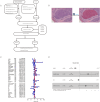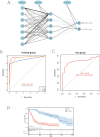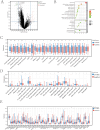Constructing a neural network model based on tumor-infiltrating lymphocytes (TILs) to predict the survival of hepatocellular carcinoma patients
- PMID: 40292102
- PMCID: PMC12032962
- DOI: 10.7717/peerj.19351
Constructing a neural network model based on tumor-infiltrating lymphocytes (TILs) to predict the survival of hepatocellular carcinoma patients
Abstract
Background: Hepatocellular carcinoma (HCC) is the most common primary liver cancer worldwide, and early pathological diagnosis is crucial for formulating treatment plans. Despite the widespread attention to pathology in the treatment of HCC patients, a large amount of information contained in pathological images is often overlooked.
Methods: We retrospectively collected clinical data and pathological slide images from (a) 331 HCC patients at Qingdao University Affiliated Hospital between January 2013 and December 2016 and (b) 180 HCC patients from The Cancer Genome Atlas (TCGA). After data screening, precise quantification of various cell types was achieved using QuPath software. Key factors related to the survival prognosis of pathologically confirmed HCC patients were identified through Cox regression and neural network models, and potential therapeutic targets were screened.
Results: Our study showed that tumour-infiltrating lymphocytes (TILs) had a protective effect. We quantified the TILs index by machine learning and built a neural network model to predict the prognostic risk of patients (ROC = 0.836 for training set ROC validation set). 95% CI [0.7688-0.896], and there was a significant difference in prognosis in the high-low risk group predicted by the model (p = 2.6e-18, HR = 0.18, 95% CI [0.12-0.27], and TNFSF4 was identified as a possible immunotherapy target.
Conclusion: This study included a total of 511 patients, divided into a training cohort of 331 cases (from Qingdao University Hospital between January 2013 and December 2016) and a validation cohort of 180 cases (TCGA). The results revealed that tumor-infiltrating lymphocytes (TILs) have a protective effect and successfully predicted the survival risk of liver cancer patients using machine learning and neural network technology. The discovery of TNFSF4 provides a new potential target for immunotherapy.
Keywords: Digital pathology; Hepatocellular carcinoma; Immune infiltration; Machine learning; Neural network model.
© 2025 Zhong et al.
Conflict of interest statement
The authors declare that they have no competing interests.
Figures





Similar articles
-
The density of tumor-infiltrating lymphocytes and prognosis in resectable hepatocellular carcinoma: a two-phase study.Aging (Albany NY). 2021 Mar 19;13(7):9665-9678. doi: 10.18632/aging.202710. Epub 2021 Mar 19. Aging (Albany NY). 2021. PMID: 33744864 Free PMC article.
-
VISTA expression associated with CD8 confers a favorable immune microenvironment and better overall survival in hepatocellular carcinoma.BMC Cancer. 2018 May 2;18(1):511. doi: 10.1186/s12885-018-4435-1. BMC Cancer. 2018. PMID: 29720116 Free PMC article.
-
Significance of tumor-infiltrating immunocytes for predicting prognosis of hepatitis B virus-related hepatocellular carcinoma.World J Gastroenterol. 2019 Sep 21;25(35):5266-5282. doi: 10.3748/wjg.v25.i35.5266. World J Gastroenterol. 2019. PMID: 31558872 Free PMC article.
-
Tumor-infiltrating lymphocytes and hepatocellular carcinoma: pathology and clinical management.Int J Clin Oncol. 2010 Dec;15(6):552-8. doi: 10.1007/s10147-010-0131-0. Epub 2010 Oct 21. Int J Clin Oncol. 2010. PMID: 20963618 Review.
-
Clinicopathologic and prognostic significance of tumor-infiltrating CD8+ T cells in patients with hepatocellular carcinoma: A meta-analysis.Medicine (Baltimore). 2019 Jan;98(2):e13923. doi: 10.1097/MD.0000000000013923. Medicine (Baltimore). 2019. PMID: 30633166 Free PMC article. Review.
References
-
- Bankhead P, Loughrey MB, Fernández JA, Dombrowski Y, McArt DG, Dunne PD, McQuaid S, Gray RT, Murray LJ, Coleman HG, James JA, Salto-Tellez M, Hamilton PW. QuPath: open source software for digital pathology image analysis. Scientific Reports. 2017;7(1):16878. doi: 10.1038/s41598-017-17204-5. - DOI - PMC - PubMed
MeSH terms
LinkOut - more resources
Full Text Sources
Medical

